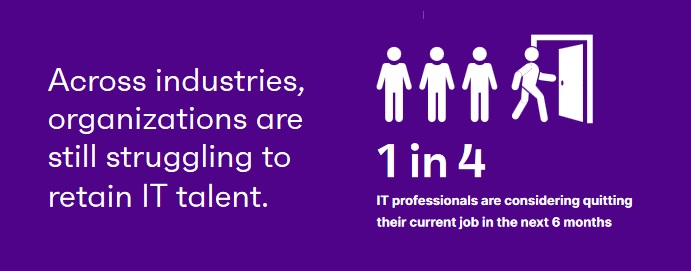One quarter of IT professionals are seriously contemplating leaving their current jobs within the next six months, potentially costing US companies upwards of $145 billion, according to the Defending IT Talent Report from Ivanti.

These statistics highlight the pressing need for organizations to relieve the burden experienced by IT professionals due to the shift to hybrid and remote work.
According to the research, IT professionals are 1.4 times more likely to disengage and "quiet quit" their jobs compared to other knowledge workers. Furthermore, a mere 8% of organizations are prioritizing automation for repetitive tasks in 2023, despite its potential to alleviate the workload pressures faced by IT teams.
The report reveals several key challenges faced by IT professionals and security experts:
■ 73% increase in workloads due to hybrid or remote working, leading to 1 in 4 reporting burnout.
■ 23% cite loss of connection to colleagues compared to just 17% of office workers.
■ 2.5 times more likely to work longer hours when working remotely.
■ Among the quarter considering quitting their jobs, 31% report their mental health is suffering.
Despite these challenges, the vast majority of IT professionals (84%) want to continue to work remotely at least some of the time.
"IT teams are the driving force making Everywhere Work a reality for organizations, yet they are grappling with a heavy workload," said Jeff Abbott, CEO at Ivanti. "In fact, organizations continue to struggle to retain IT talent (a decades long problem) — and it is costing them productivity gains and affecting their bottom line. Companies must embrace automation to alleviate IT workloads, ultimately fostering a destination environment that retains premier IT professionals and cultivates a competitive advantage. We've spent years digitally transforming all corners of the business, now is the time to transform the IT environments and help the people that make all of the transformation possible."
The report emphasizes that IT talent disengagement, quiet quitting, and turnover are not a result of remote work itself but stem from the lack of resources, tools, and support available to these employees.
The report outlines six actionable steps businesses can take to enable Everywhere Work for IT and security professionals:
Diagnose IT work-life pressure points
Use internal surveys and one-on-ones to get a pulse on mindsets at work. From there, take note of the specific pressure points brought on by hybrid and remote work.
Inventory tech-specific experiences
IT talent report higher rates of dissatisfaction with the tools they use when working offsite (nearly 1 in 4 say this). By tracking digital employee experience (DEX), the insights can help pinpoint areas that need attention/investment.
Prioritize automation for IT workflows
To free up IT talent for more valuable projects, invest in technology that handles repetitive tasks automatically and apply workflow automation to both employee-facing activities as well as back-office workflows.
Adopt proactive solutions
To minimize help desk tickets, deploy so-called "self-healing" systems that use a combination of AI, machine learning and remote monitoring to resolve workplace technology slowdowns before an employee is even aware of the problem.
Give employees choices about how they work
Offer IT talent the chance to define the work style that suits their individual circumstances, and in doing so, boost IT recruitment and retention.
Foster in-person connection for IT teams
Face-to-face meetings present an opportunity to build trust and camaraderie. It's easier to have a connection with someone on the other side of the screen if the team just spent the day having lunch and hanging out together.
Methodology: To gain a better understanding of the impact of Everywhere Work on IT talent, Ivanti surveyed 1,800 IT professionals and C-level executives across the globe. The goal was to get a pulse on the quality of their work lives, the impact of flexible and hybrid work arrangements on workload, and what organizations can do to support and retain high-value IT talent.
